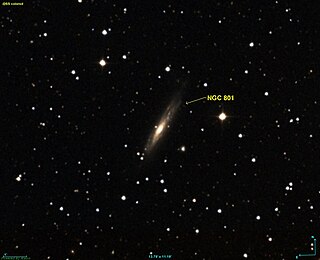
NGC 801 is a spiral galaxy with an active galaxy core in the constellation Andromeda. It is estimated to be 174 million light-years from the Milky Way and has a diameter of approximately 174,400 light-years. The object was discovered on September 20, 1885 by the American astronomer Lewis A. Swift.

NGC 995 is a lenticular galaxy located in the constellation Andromeda about 178 million light years from the Milky Way. It was discovered by the French astronomer Édouard Stephan on 8 December 1871.

NGC 820 is a spiral galaxy located in the constellation Aries about 210 million light-years from the Milky Way. It was discovered by British astronomer John Herschel in 1828.

NGC 830 is a barred lenticular galaxy in the constellation Cetus. It is estimated to be about 170 million light-years from the Milky Way and has a diameter of approximately 70,000 light years.

NGC 840 is a barred spiral galaxy in the constellation Cetus south of the ecliptic. It is estimated to be about 300 million light-years from the Milky Way and has a diameter of approximately 175,000 ly.

NGC 900 is a lenticular galaxy located in the constellation Aries about 430 million light-years from the Milky Way. It was discovered by the German astronomer Albert Marth in 1864.

NGC 910 is an elliptical galaxy in the constellation of Andromeda. NGC 910 was discovered on October 17, 1786 by the German-British astronomer William Herschel. It is the brightest galaxy in the cluster Abell 347.
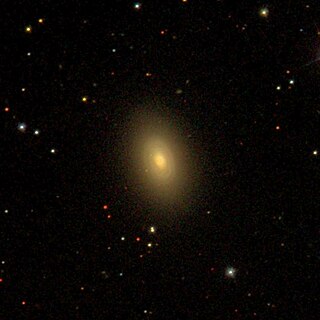
NGC 940 is a lenticular galaxy in the constellation Triangulum. It is estimated to be 222 million light-years from the Milky Way and has a diameter of approximately 80,000 ly. NGC 940 was discovered by Heinrich d'Arrest.

NGC 980 is a lenticular galaxy located in the constellation Andromeda about 256 million light years from the Milky Way. It was discovered by the German - British astronomer William Herschel in 1786.

NGC 530, also known as IC 106, is a lenticular galaxy in the constellation Cetus. It is approximately 226 million light years from the Milky Way and has a diameter of around 100,000 light years. The object was discovered on November 20, 1886, by the American astronomer Lewis A. Swift, who listed it as NGC 530, and rediscovered on November 16, 1887, by Guillaume Bigourdan, who listed it as IC 106.
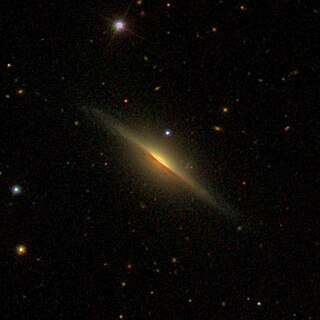
NGC 825 is an unbarred spiral galaxy in the constellation Cetus, estimated to be 154 million light-years away. The object was discovered by the astronomer Albert Marth on November 18, 1863.
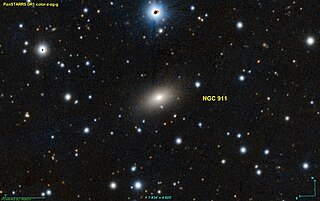
NGC 911 is an elliptical galaxy located in the constellation Andromeda about 258 million light years from the Milky Way. It was discovered by French astronomer Édouard Stephan on 30 October 1878. It is a member of the galaxy cluster Abell 347.

NGC 912 is a compact lenticular galaxy located in the constellation Andromeda about 197 million light years from the Milky Way. It was discovered by French astronomer Édouard Stephan in 1878.

NGC 913 is a lenticular galaxy located in the constellation Andromeda about 224 million light years from the Milky Way. It was discovered by French astronomer Édouard Stephan in 1878.
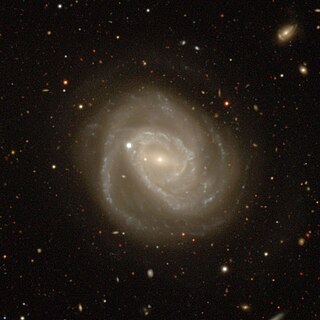
NGC 782 is a barred spiral galaxy located in the constellation Eridanus about 160 million light-years from the Milky Way. It was discovered by British astronomer John Herschel in 1834.

NGC 938 is an elliptical galaxy located in the constellation Aries, approximately 184 million light years from the Milky Way. It was discovered by the Prussian astronomer Heinrich d'Arrest in 1863.

NGC 821 is an elliptical galaxy in the constellation Aries. It is estimated to be about 80 million light-years from the Milky Way and has a diameter of approximately 55,000 light years. NGC 821 was discovered on September 4, 1786, by astronomer Wilhelm Herschel.
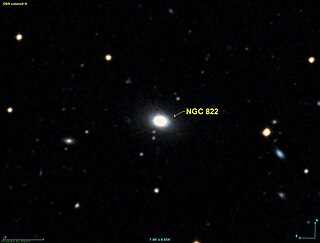
NGC 822 is an elliptical galaxy in the constellation Phoenix. It is estimated to be about 233 million light-years from the Milky Way and has a diameter of approximately 80,000 light-years. NGC 822 was discovered on September 5, 1834, by astronomer John Herschel.

NGC 721 is a barred spiral galaxy located in the constellation Andromeda about 250 million light years from the Milky Way. It was discovered by the Prussian astronomer Heinrich d'Arrest in 1862.

NGC 862 is an elliptical galaxy located in the constellation of Phoenix about 241 million light years from the Milky Way. It was discovered by the British astronomer John Herschel in 1834.




















